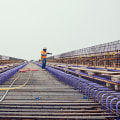As an expert in transportation and urban planning, I have been closely following the development of rail projects in Los Angeles County, CA. With a population of over 10 million people, Los Angeles County is the most populous county in the United States. It is also known for its notorious traffic congestion, which has been a major concern for both residents and visitors alike.
The Need for Rail Projects
In recent years, the county has seen a significant increase in population and economic growth. This has led to a rise in the number of vehicles on the road, resulting in longer commute times and air pollution.The existing transportation infrastructure, mainly consisting of highways and roads, has struggled to keep up with the growing demand. Recognizing the need for a more efficient and sustainable mode of transportation, the Los Angeles County Metropolitan Transportation Authority (Metro) has been investing in rail projects to improve mobility and reduce traffic congestion.
The Current State of Rail Projects
Metro currently operates six rail lines, covering a total of 105 miles. These include the Blue, Red, Purple, Gold, Green, and Expo lines. The Blue Line, which connects Downtown Los Angeles to Long Beach, is the oldest and busiest line, with an average daily ridership of over 80,000 passengers. The Expo Line, which runs from Downtown Los Angeles to Santa Monica, was completed in 2016 and has quickly become one of the most popular lines. It has also played a significant role in revitalizing the neighborhoods it serves. The newest addition to Metro's rail network is the Crenshaw/LAX Line, which is currently under construction.This 8.5-mile line will connect the Green and Expo lines, providing a direct connection to Los Angeles International Airport (LAX). It is expected to open in 2022 and is estimated to serve over 16,000 daily riders.
The Future of Rail Projects
Metro has an ambitious plan to expand its rail network in the coming years. The Los Angeles County Traffic Improvement Plan, also known as Measure M, was approved by voters in 2016. This half-cent sales tax increase will generate an estimated $120 billion over the next 40 years, with a significant portion allocated for rail projects.One of the most anticipated projects is the Purple Line Extension, which will extend the existing Purple Line from its current terminus at Wilshire/Western to Westwood. This 9-mile extension will add seven new stations and is expected to serve over 49,000 daily riders.It is scheduled to open in phases, with the first section to La Cienega Boulevard set to open in 2023. Another major project is the Regional Connector, which will connect the Blue, Expo, and Gold lines through Downtown Los Angeles. This 1.9-mile underground tunnel will reduce travel time and provide a seamless transfer between lines. It is expected to open in 2022 and serve over 88,000 daily riders. In addition to these major projects, Metro also has plans for several other rail projects, including the West Santa Ana Branch Transit Corridor, Sepulveda Transit Corridor, and East San Fernando Valley Transit Corridor. These projects will further expand the rail network and provide better connectivity to various parts of the county.
The Expected Ridership
With the completion of these rail projects, Metro is expecting a significant increase in ridership.According to their projections, the total daily ridership on all rail lines is expected to reach over 1 million by 2035. This is a significant increase from the current ridership of around 350,000 passengers per day. The Purple Line Extension and Regional Connector are expected to have the highest ridership, with over 100,000 daily passengers each. The Crenshaw/LAX Line and other planned projects are also expected to see a substantial increase in ridership.
The Impact on Los Angeles County
The completion of these rail projects will have a significant impact on Los Angeles County. It will not only improve mobility and reduce traffic congestion but also bring economic benefits to the region. The construction of these projects will create thousands of jobs, and the improved connectivity will attract new businesses and investments. Moreover, the expansion of the rail network will also have a positive impact on the environment.With more people opting for public transportation, there will be a reduction in greenhouse gas emissions and air pollution.







